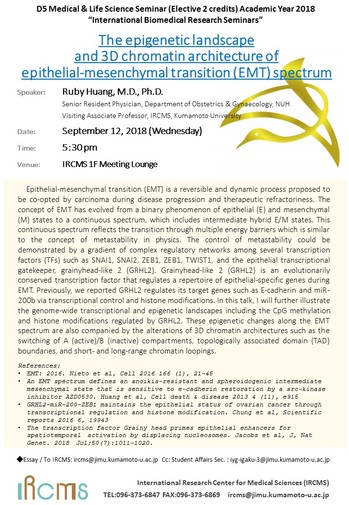- HOME
- News & Events
- [September 12]*D5 Medical & Life Science Seminar*
News & Events
[September 12]*D5 Medical & Life Science Seminar*
August 14 2018
The "D5 Medical & Life Science Seminar" course will be offered by International Research Center for Medical Sciences (IRCMS). It will run from May 2018 to March 2019, with lectures given by scientists affiliated or collaborated with the IRCMS. The course theme for this academic year is "Basic research for understanding disease mechanisms". The lectures will be given once a month, in English, and by leading scientists in the relevant research field. Students will be taught: 1) how normal physiological functions are maintained in human hematopoietic, vascular, immune, reproductive and nervous tissues and organs; 2) how abnormalities in these systems (e.g., cancer) are studied using experimental models; 3) cutting-edge technologies (including single cell level imaging and omics analysis) used for mechanistic understanding of these abnormalities; 4) efforts and progresses in finding cure for human diseases associated with these abnormalities; and 5) importance of understanding disease mechanisms using
Date : September 12, 2018 (Wed)
Time : 17:30 -
Venue : IRCMS 1F Meeting Lounge
Speaker : Ruby Huang, M.D., Ph.D.
Title : The epigenetic landscape and 3D chromatin architecture of epithelial-mesenchymal
transition (EMT) spectrum
Abstract :
Epithelial-mesenchymal transition (EMT) is a reversible and dynamic process proposed to be co-opted by carcinoma during disease progression and therapeutic refractoriness. The concept of EMT has evolved from a binary phenomenon of epithelial (E) and mesenchymal (M) states to a continuous spectrum, which includes intermediate hybrid E/M states. This continuous spectrum reflects the transition through multiple energy barriers which is similar to the concept of metastability in physics. The control of metastability could be demonstrated by a gradient of complex regulatory networks among several transcription factors (TFs) such as SNAI1, SNAI2, ZEB1, ZEB1, TWIST1, and the epithelial transcriptional gatekeeper, grainyhead-like 2 (GRHL2). Grainyhead-like 2 (GRHL2) is an evolutionarily conserved transcription factor that regulates a repertoire of epithelial-specific genes during EMT. Previously, we reported GRHL2 regulates its target genes such as E-cadherin and miR-200b via transcriptional control and histone modifications. In this talk, I will further illustrate the genome-wide transcriptional and epigenetic landscapes including the CpG methylation and histone modifications regulated by GRHL2. These epigenetic changes along the EMT spectrum are also companied by the alterations of 3D chromatin architectures such as the switching of A (active)/B (inactive) compartments, topologically associated domain (TAD) boundaries, and short- and long-range chromatin loopings.
References:
- EMT: 2016. Nieto et al, Cell 2016 166 (1), 21-45
- An EMT spectrum defines an anoikis-resistant and spheroidogenic intermediate mesenchymal state that is sensitive to e-cadherin restoration by a src-kinase inhibitor AZD0530. Huang et al, Cell death & disease 2013 4 (11), e915
- GRHL2-miR-200-ZEB1 maintains the epithelial status of ovarian cancer through transcriptional regulation and histone modification. Chung et al, Scientific reports 2016 6, 19943
- The transcription factor Grainy head primes epithelial enhancers for spatiotemporal activation by displacing nucleosomes. Jacobs et al, J, Nat Genet. 2018 Jul;50(7):1011-1020.



